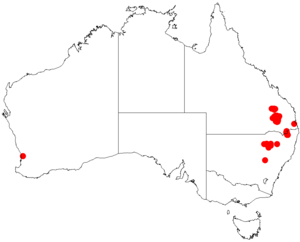Spindly wattle facts for kids
Quick facts for kids Spindly wattle |
|
|---|---|
| Scientific classification | |
| Genus: |
Acacia
|
| Species: |
debilis
|
 |
|
| Occurrence data from AVH | |
The Acacia debilis, commonly called the spindly wattle, is a type of wattle plant. It is a shrub or small tree that grows naturally in eastern Australia.
What Does It Look Like?
The spindly wattle usually grows as a shrub or a tree. It can reach a height of about 2.5 to 6 metres (8 to 20 ft). Its shape can be upright or spread out, and it has smooth bark that is grey to reddish-green.
Its branches are round and smooth, sometimes with ridges. The leaves are also smooth and have a stalk (called a petiole) that is about 1 to 4 cm (0.39 to 1.57 in) long. Each leaf is made up of one to four pairs of smaller leaf sections called pinnae. These pinnae are 3 to 9.5 cm (1.2 to 3.7 in) long. On each pinna, there are 5 to 17 pairs of even smaller leaflets called pinnules. These pinnules are shaped like a rectangle, measuring 6 to 20 mm (0.24 to 0.79 in) long and 2 to 6 mm (0.079 to 0.236 in) wide.
The spindly wattle flowers between July and September. Its flowers grow in groups of 8 to 25. These groups can be found along the branches or in larger clusters called panicles, which can be 2 to 20 cm (0.79 to 7.87 in) long. The flower-heads are round, about 4 to 7.5 mm (0.16 to 0.30 in) across, and have 15 to 33 bright yellow flowers.
After the flowers, smooth, thin, and slightly leathery seed pods form. These pods have a white, powdery coating. They are mostly straight or slightly curved. The pods are flat and usually have straight sides. They measure 5.5 to 13.5 cm (2.2 to 5.3 in) long and 9 to 13 mm (0.35 to 0.51 in) wide.
Where Does It Grow?
The spindly wattle is a plant that is only found in a small part of eastern Australia. It grows in southeastern Queensland and northeastern New South Wales. Its growing areas are not continuous; they are spread out.
In New South Wales, you can find it north of the Pilliga scrub. It often grows along creek banks. It is usually part of dry sclerophyll forests or woodlands. Sclerophyll forests are types of forests where plants have hard, tough leaves to help them survive dry conditions. The spindly wattle prefers sandy soils.
The plant's range stretches from around Taroom in the north. It goes down to the Pilliga East State Forest in the southwest. It also reaches Tenterfield in the southeast.

